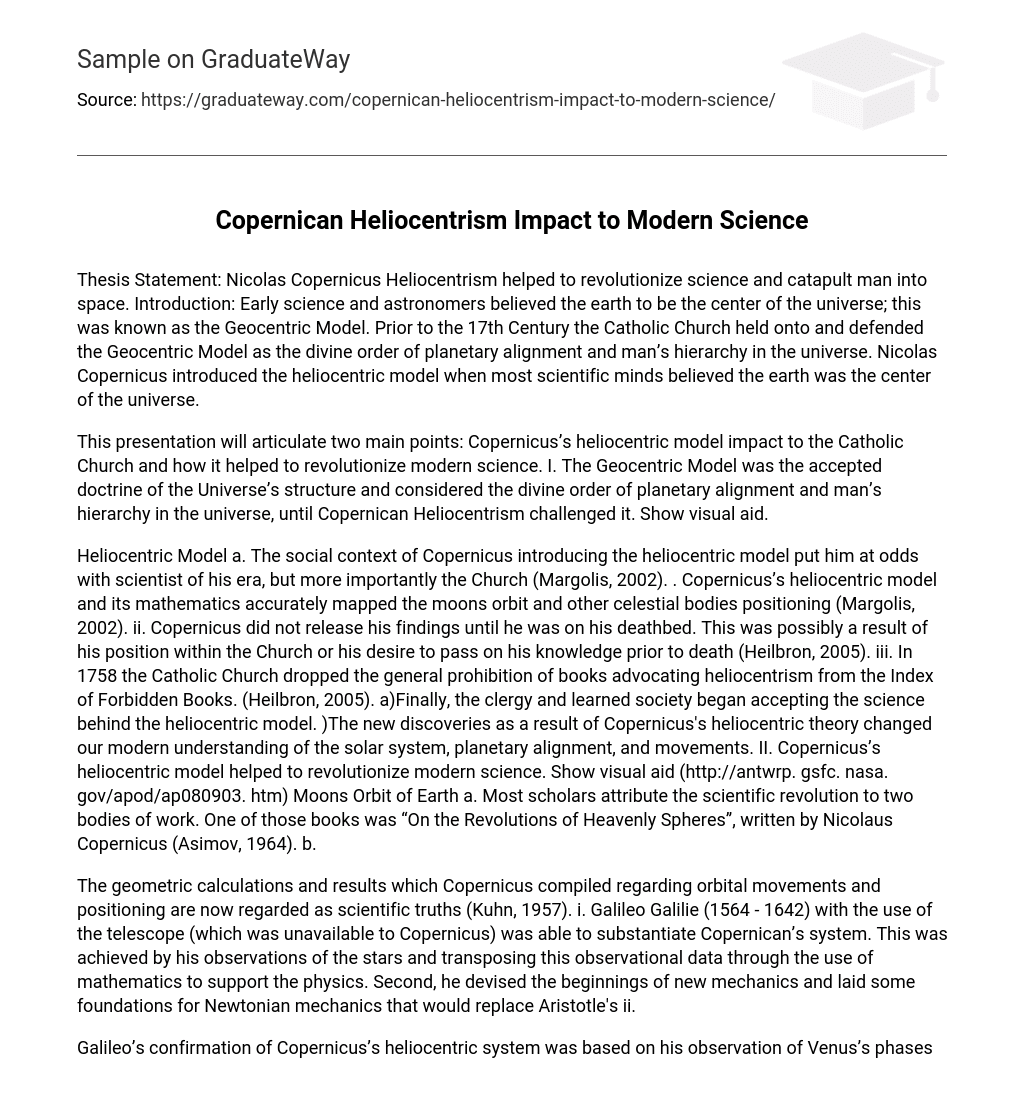Thesis Statement: Nicolas Copernicus Heliocentrism helped to revolutionize science and catapult man into space. Introduction: Early science and astronomers believed the earth to be the center of the universe; this was known as the Geocentric Model. Prior to the 17th Century the Catholic Church held onto and defended the Geocentric Model as the divine order of planetary alignment and man’s hierarchy in the universe. Nicolas Copernicus introduced the heliocentric model when most scientific minds believed the earth was the center of the universe.
This presentation will articulate two main points: Copernicus’s heliocentric model impact to the Catholic Church and how it helped to revolutionize modern science. I. The Geocentric Model was the accepted doctrine of the Universe’s structure and considered the divine order of planetary alignment and man’s hierarchy in the universe, until Copernican Heliocentrism challenged it. Show visual aid.
Heliocentric Model a. The social context of Copernicus introducing the heliocentric model put him at odds with scientist of his era, but more importantly the Church (Margolis, 2002). . Copernicus’s heliocentric model and its mathematics accurately mapped the moons orbit and other celestial bodies positioning (Margolis, 2002). ii. Copernicus did not release his findings until he was on his deathbed. This was possibly a result of his position within the Church or his desire to pass on his knowledge prior to death (Heilbron, 2005). iii. In 1758 the Catholic Church dropped the general prohibition of books advocating heliocentrism from the Index of Forbidden Books. (Heilbron, 2005). a)Finally, the clergy and learned society began accepting the science behind the heliocentric model. )The new discoveries as a result of Copernicus’s heliocentric theory changed our modern understanding of the solar system, planetary alignment, and movements. II. Copernicus’s heliocentric model helped to revolutionize modern science. Show visual aid (http://antwrp. gsfc. nasa. gov/apod/ap080903. htm) Moons Orbit of Earth a. Most scholars attribute the scientific revolution to two bodies of work. One of those books was “On the Revolutions of Heavenly Spheres”, written by Nicolaus Copernicus (Asimov, 1964). b.
The geometric calculations and results which Copernicus compiled regarding orbital movements and positioning are now regarded as scientific truths (Kuhn, 1957). i. Galileo Galilie (1564 – 1642) with the use of the telescope (which was unavailable to Copernicus) was able to substantiate Copernican’s system. This was achieved by his observations of the stars and transposing this observational data through the use of mathematics to support the physics. Second, he devised the beginnings of new mechanics and laid some foundations for Newtonian mechanics that would replace Aristotle’s ii.
Galileo’s confirmation of Copernicus’s heliocentric system was based on his observation of Venus’s phases in relation to the sun. His perseverance ensured the Copernican theory evolved into the 21st century. c. Copernicus theory became a major factor in modern space travel and other scientific innovations (Asimov, 1964). i. The heliocentric discoveries have become the cornerstones of breakthroughs in physics, astronomy and geometry. Conclusion: Early Church scholars believed that the earth held the planets in alignment.
Galileo Galilie (1564 – 1642) with the use of the telescope (which was unavailable to Copernicus) was able to substantiate Copernican’s system. Galileo’s confirmation of Copernicus’s Heliocentric system based on his observation of Venus’s phases in relation to the sun, ensured the Copernican theory evolved into the 21st century. The Copernican revolution was arguably completed by Isaac Newton whose Philosophiae Naturalis Principia Mathematica provided a consistent physical explanation which showed that the planets are kept in their orbits by the familiar force of gravity.
The geometric calculations and results which Copernicus compiled regarding orbital movements and positioning are now regarded as scientific truths. The heliocentric discoveries have become the cornerstones of breakthroughs in physics, astronomy and geometry. Without Copernicus’s heliocentric model modern man could not have achieved space flight or reached the moon. Copernicus’s theory became a major factor in modern space travel and other scientific innovations. (Asimov, 1964) ? Scripted Audience Questions
Question: Why did the Church fight the heliocentric model so strongly? Answer: Anyone who disagreed with this analogy that the Geocentric Model as the divine order of planetary alignment and man’s hierarchy in the universe was branded a heretic, because it was considered going against Biblical doctrine. Question: In what way did Copernicus impact early science? Answer: Copernicus’s heliocentric model and its mathematics accurately mapped the moons orbit and other celestial bodies positioning. Question: How did Copernicus model help modern science?
Answer: As I touched on earlier, Copernicus’s theory became a major factor in modern space travel and other scientific innovations. His geometric calculations and results regarding orbital movements helped modern man understand gravity and celestial body travel. The main reasoning for showing the Heliocentric Model is to provide a visual to the audience that the heliocentric model differs from the Geocentric Model by virtue of the Earths location. In the Geocentric ideology, Earth was considered at the center and the Sun along with other planetary bodies revolved around the earth.
The Copernican heliocentric model placed the Sun at the center of the Universe and Earth As the third planet from the Sun. Moon Orbit of Earth The reason for using this photo was to illustrate the movement of the moon around the earth and show how Copernicus’s calculations accurately mapped celestial body movements. This was one of his advances to astronomy and science.
References Asimov, Isaac (1964). Asimov biographical encyclopedia of science and technology: Doubleday & Co. Publishers Heilbron, John L. 2005) Censorship of Astronomy in Italy after Galileo (in McMullin, Ernan ed. , The Church and Galileo, University of Notre Dame Press, Notre Dame Kuhn, T. (1957) The Copernican Revolution, Harvard University Press, Cambridge. Margolis, H. (2002) It Started With Copernicus: How Turning the World Inside Out Led to the Scientific Revolution, New York: McGraw-Hill Aristarchus (270 B. C. ) Heliocentric Model Retrieved at http://abyss. uoregon. edu/~js/images/Aristarchus_SS. gif Lindler D. , (2008) Moons Orbit of Earth Retrieved at http://antwrp. gsfc. nasa. gov/apod/ap080903. html





